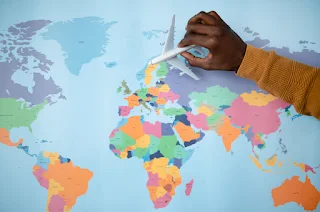"Migration and Development "
Migration and development is a multifaceted topic that explores the complex relationship between migration patterns and their impact on the development of origin and destination regions. It encompasses the economic, social, and political dimensions of migration, examining how migration can both contribute to and hinder development outcomes in various contexts around the world. From remittances and brain drain to cultural exchange and demographic shifts, migration and development intersect in dynamic ways, influencing societies, economies, and policies globally.
 |
| Migration and Development |
Introduction to Migration and Development
Migration and development represent two interconnected phenomena shaping the global landscape. Migration, the movement of people from one place to another, whether within a country or across borders, is a fundamental aspect of human history. Development, on the other hand, encompasses the economic, social, and environmental progress of societies. The relationship between migration and development is intricate and multifaceted, with migration influencing development outcomes and vice versa.
Migration plays a significant role in driving economic growth, cultural exchange, and demographic dynamics. It can contribute to development through various channels, such as remittances sent back to origin countries, knowledge and skills transfer, entrepreneurship, and labor market dynamics. However, migration also poses challenges, including brain drain, social tensions, and issues related to migrant rights and integration.
Understanding the dynamics of migration and development is crucial for policymakers, researchers, and practitioners seeking to address global challenges such as poverty alleviation, economic inequality, and sustainable development. By examining the impacts of migration on both sending and receiving communities, as well as the factors driving migration patterns, we can develop more effective policies and interventions to harness the potential benefits of migration while mitigating its negative consequences.
How does migration impact economic development in sending and receiving countries?
Migration has significant impacts on economic development in both sending and receiving countries:
Sending Countries:
Remittances: Migration often leads to the transfer of money, known as remittances, from migrants working abroad to their families back home. Remittances can provide a crucial source of income for households in sending countries, contributing to poverty reduction, increased consumption, and investment in education, healthcare, and small businesses.
Brain Drain vs. Brain Gain:
Migration of skilled workers, often referred to as brain drain, can deprive sending countries of valuable human capital. However, it can also create opportunities for knowledge transfer and skill development, potentially leading to brain gain when migrants return home with enhanced skills and experiences.
Labor Market Dynamics:
Migration can alleviate labor shortages in sending countries by reducing unemployment and underemployment. It can also lead to shifts in the composition of the labor force, affecting wages, productivity, and industry competitiveness.
Receiving Countries:
Labor Force Growth: Migration contributes to the growth of the labor force in receiving countries, filling gaps in the workforce, particularly in sectors with labor shortages such as healthcare, agriculture, and construction.
Innovation and Entrepreneurship:
Migrants often bring diverse skills, knowledge, and entrepreneurial spirit to receiving countries, fueling innovation, creativity, and economic dynamism.
Cultural Diversity:
Migration enriches the cultural fabric of receiving countries, fostering cross-cultural exchange, creativity, and tolerance, which can have positive social and economic effects.
While migration can bring various economic benefits to both sending and receiving countries, it also poses challenges such as brain drain, labor market competition, social tensions, and issues related to migrant rights and integration. Effective policies and strategies are needed to maximize the benefits of migration while addressing its potential drawbacks and ensuring inclusive and sustainable development for all stakeholders.
What are the drivers of migration in developing countries?
Several factors drive migration in developing countries:
Economic Opportunities:
Economic disparities between regions and countries often compel individuals to migrate in search of better job opportunities, higher wages, and improved living standards. Limited employment prospects, low wages, and lack of economic opportunities in rural areas or small towns may prompt people to move to urban centers or to seek employment abroad.
Conflict and Violence:
Political instability, armed conflict, persecution, and human rights abuses force many individuals and families to flee their homes in search of safety and security. Internal displacement and cross-border migration are common responses to conflict-driven migration.
Environmental Factors:
Environmental degradation, natural disasters, and climate change exacerbate existing vulnerabilities and can displace populations, particularly in regions prone to droughts, floods, hurricanes, and other environmental hazards. This type of migration, often referred to as environmental or climate-induced migration, can be temporary or permanent.
Demographic Pressures:
Rapid population growth, coupled with limited access to resources and opportunities, can strain social and economic systems, leading to migration as individuals seek to alleviate pressure on resources or pursue better opportunities elsewhere.
Social and Cultural Factors:
Social networks, family ties, and cultural factors play a significant role in shaping migration patterns. Migration may be influenced by family reunification, marriage, education opportunities, or cultural ties to specific communities or countries.
Political and Policy Factors:
Government policies, such as immigration laws, border controls, visa regimes, and labor market regulations, can influence migration flows by either facilitating or restricting movement. Political developments, such as changes in government, shifts in migration policies, or international agreements, also impact migration patterns.
Technological Advancements:
Advances in transportation and communication technologies have reduced the cost and barriers to migration, making it easier for people to move across borders and facilitating transnational networks and connections.
Understanding these drivers of migration in developing countries is crucial for policymakers, humanitarian organizations, and development practitioners to design effective policies and interventions that address the root causes of migration, protect the rights of migrants, and promote sustainable development for sending and receiving communities.
How can migration policies be designed to maximize development benefits?
Migration policies can be designed to maximize development benefits through a combination of strategies aimed at harnessing the positive aspects of migration while mitigating potential drawbacks. Here are some key considerations:
Promoting Regular and Safe Migration:
Facilitating regular and safe migration pathways can reduce the reliance on irregular and dangerous migration routes, enhancing migrants' safety and well-being. This includes establishing legal channels for migration, such as work visas, family reunification programs, and refugee resettlement schemes, while also combating human trafficking and migrant exploitation.
Supporting Migrant Integration:
Integration policies that support migrants' social, cultural, and economic inclusion in receiving communities are essential for maximizing their contributions to development. This includes providing language training, access to education and healthcare, recognition of foreign qualifications, and support for labor market integration and entrepreneurship.
Facilitating Remittance Flows:
Policies that reduce the cost and increase the efficiency of remittance transfers can maximize the development impact of remittances. This may involve promoting competition among remittance service providers, reducing transaction fees, improving financial infrastructure, and offering incentives for investments in productive activities in sending countries.
Addressing Brain Drain and Brain Gain:
Strategies to mitigate brain drain and promote brain gain involve investing in education, research, and skills development in sending countries to retain and attract skilled workers. This may include scholarship programs, research partnerships, and initiatives to create conducive environments for innovation and entrepreneurship.
Fostering Diaspora Engagement:
Engaging diaspora communities can leverage their skills, resources, and networks for development purposes. This may involve establishing diaspora investment funds, facilitating knowledge exchange and technology transfer, and creating platforms for diaspora philanthropy and volunteerism.
Promoting Circular Migration:
Circular migration programs that allow migrants to move between their home and host countries in a cyclical manner can maximize the benefits of migration while minimizing the social and economic costs. This includes temporary migration schemes, seasonal worker programs, and initiatives that promote return and reintegration.
Mainstreaming Migration into development Policies:
Integrating migration considerations into broader development frameworks and policies can ensure that migration is viewed as an integral aspect of development planning. This involves coordinating across sectors such as labor, education, health, and social welfare to address the multifaceted dimensions of migration and development.
By adopting a comprehensive and balanced approach to migration policy design, governments can unlock the potential of migration as a driver of inclusive and sustainable development for both sending and receiving countries.
What are the challenges and opportunities of remittances for development?
Remittances present both challenges and opportunities for development:
Challenges:
Dependency: Heavy reliance on remittances can create a dependency on migrant income, making sending countries vulnerable to fluctuations in remittance flows. In some cases, remittances may replace productive investments or discourage domestic entrepreneurship and economic diversification.
Macroeconomic Impacts: Large inflows of remittances can lead to exchange rate appreciation, which may harm export-oriented industries by making their products more expensive in international markets. This phenomenon, known as the "Dutch disease," can hinder long-term economic development and competitiveness.
Financial Exclusion:
Remittance recipients, particularly in rural or marginalized areas, may face challenges accessing formal financial services, leading to financial exclusion and limiting their ability to save, invest, or access credit.
Social Dynamics:
Remittances can also have unintended social consequences, such as altering family dynamics, fostering dependency, or creating inequalities within communities based on remittance-receiving households and non-receiving households.
Opportunities:
Poverty Alleviation: Remittances are a direct and reliable source of income for many households in developing countries, lifting families out of poverty, improving living standards, and enhancing access to education, healthcare, and other essential services.
Economic Stability: Remittances can contribute to macroeconomic stability by providing a steady source of foreign exchange, buffering against external shocks, and reducing reliance on volatile sources of income such as commodity exports or foreign aid.
Local Economic Development:
Remittances can stimulate local economies through increased consumption, investment in small businesses, and the creation of employment opportunities in sectors such as retail, construction, and services.
Human Capital Investment:
Remittance recipients may invest in education, skills development, and health care, leading to improvements in human capital and long-term development outcomes, including higher productivity, reduced poverty, and improved social mobility.
Financial Inclusion:
Remittances provide an entry point for financial inclusion initiatives, encouraging the development of formal banking systems, mobile money platforms, and other financial services tailored to the needs of remittance recipients.
Overall, while remittances offer significant potential for development, policymakers must address the challenges associated with remittance dependency, ensure that remittance flows are channeled towards productive investments, and promote policies that maximize the developmental impact of remittances while mitigating their negative effects.
In conclusion, migration and development are deeply intertwined phenomena that shape societies, economies, and policies around the world. Migration, driven by various economic, social, environmental, and political factors, presents both challenges and opportunities for development in sending and receiving countries.
While migration can contribute to economic growth, poverty reduction, cultural exchange, and human capital development, it also poses challenges such as brain drain, labor market competition, social tensions, and issues related to migrant rights and integration. Maximizing the developmental benefits of migration requires comprehensive and balanced policy approaches that address the root causes of migration, protect the rights of migrants, and promote inclusive and sustainable development for all stakeholders.
Key policy considerations include promoting regular and safe migration, supporting migrant integration, facilitating remittance flows, addressing brain drain and brain gain, fostering diaspora engagement, promoting circular migration, and mainstreaming migration into development policies.
By adopting evidence-based, context-specific, and coordinated policy responses, governments, international organizations, civil society, and the private sector can harness the potential of migration as a driver of inclusive and sustainable development, while mitigating its negative consequences and ensuring that the benefits of migration are shared equitably among all members of society.








0 Comments